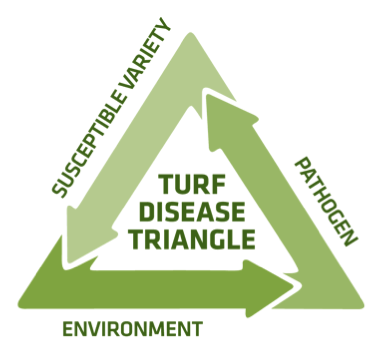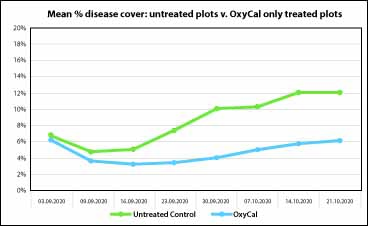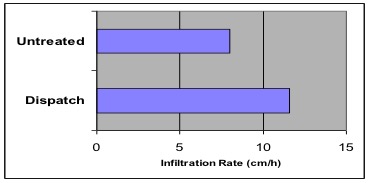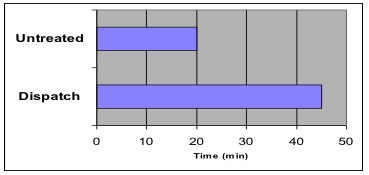Making the plant less susceptible to pathogen attack
Related Articles
It is becoming increasingly important to implement a range of alternative methods to reduce the likelihood of fungal disease outbreaks on sports turf.
When discussing fungal disease prevention it is helpful to refer to the ‘Disease Triangle’. For fungal diseases to become active within a turfgrass sward, three main factors must coincide:
- Pathogen – fungal pathogen needs to be present in the turf canopy, within organic matter (thatch) in the upper soil profile;
- Susceptible variety – the pathogen requires a host grass plant that is either a particularly susceptible variety or in a susceptible condition;
- Environment – conditions need to suit the sporulation and spread of the fungal pathogen.
A fourth factor of time, that is the length of time that the coincidence of the above three factors last, will generally determine the severity of the disease.

Pathogen
Fungal pathogens can generally be found in most turf situations. They coexist within the soil food web with many other microorganisms, but when the opportunity arises with a weakened host and perfect environment the pathogen will attack the grass plant.
Susceptible variety
If a site has a history of issues with a certain fungal disease, it is always good practice when overseeding to select species or cultivars that are less susceptible to that particular fungal pathogen.

Environment
A number of environmental factors can contribute to the conditions needed for disease, including the amount of light, heat and moisture present. The implementation of a sound integrated turf management programme can provide an environment that supports plant health (limiting susceptibility to disease) while also minimising conditions that are conducive to the growth and spread of fungal pathogens.

Independent trials carried out at Cal Poly Pomona show that Dispatch positively influences infiltration rates. (Infiltration rate in a loamy sand on an 8% slope. Dispatch Sprayable treatment increased the infiltration rate by approximately x1.4 that of the untreated.)

(Irrigation time to runoff in a loamy sand on an 8% slope. Irrigation time to run-off was more than doubled.)
Where can Aquatrols help?
A key factor in disease prevention is managing moisture effectively, and with more than 65 years of experience in the discovery and development of soil surfactants, Aquatrols has a range of products that can help.
Some diseases such as dollar spot thrive when soils are dry but the turf leaves are wet from dew, rain or irrigation. Not only does the causal fungus thrive in these conditions, but its dissemination by equipment, animals or people also increases. Other diseases such as microdochium patch tend to proliferate in the upper soil profile and thatch layer and thrive in warm, wet conditions.
Penetrants can help reduce surface wetness in both of these cases, and Dispatch Sprayable is a popular choice of the modern greenkeeper to perform this function. With its low rate of application, environmentally safe profile and track record of performance all backed by robust independent data, it sits well within integrated management programmes.
The TurfRx range includes a selection of products that assist the greenkeeper to combat the effects of abiotic stresses faced by their turf. Redox incorporates 11 distinct types of soluble carbon chemistries with plant nutrients; These components dramatically improve plant uptake, input efficiencies and results. These components function by protecting and facilitating nutrient delivery to the plant. The reduction of the negative effects caused by any abiotic environmental stresses will produce a healthier, more robust plant.
In independent trials carried out at STRI, a close-mown trial plot was selected with a sward consisting of a browntop bent / poa annua mix but that also suffered from severe shade during the duration of the chosen trial period. The applications of OxyCal assisted the treated areas in coping with the severe abiotic stress of shade, which subsequently helped them to cope with the biotic stress brought on by high microdochium patch disease pressure.
Summary
Fungicidal options for the greenkeeper have significantly reduced in recent years with many go-to products having lost their registrations. It is becoming increasingly important to implement a range of alternative methods to reduce the likelihood of fungal disease outbreaks on sports turf. Aquatrols offers a range of products that can alter the environment making it less conducive to the proliferation of the pathogen, as well as products that can help bolster the plant’s overall health so that it can better withstand the abiotic stressors that would make it more susceptible to pathogen attack.
To learn more about how Aquatrols products can be a benefit to your disease management strategy, please get in touch with your Aquatrols Territory Manager

























